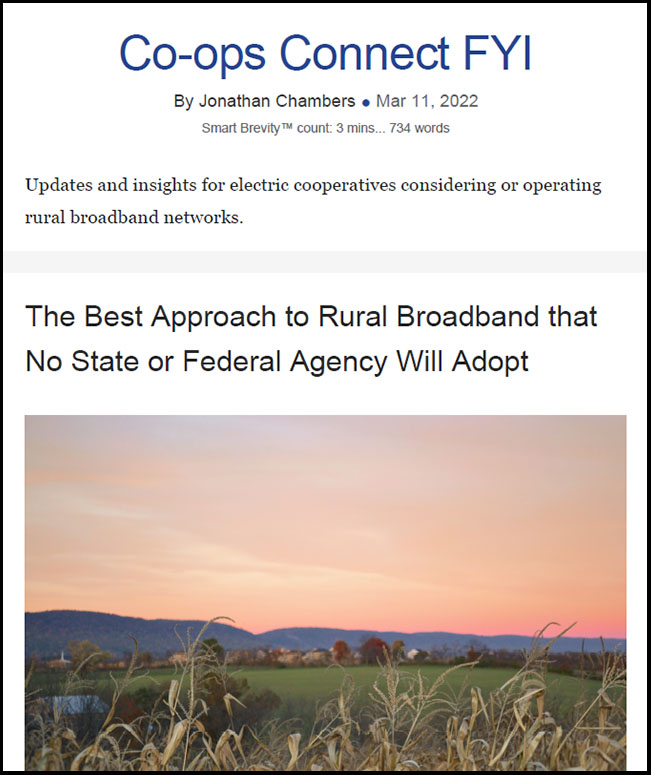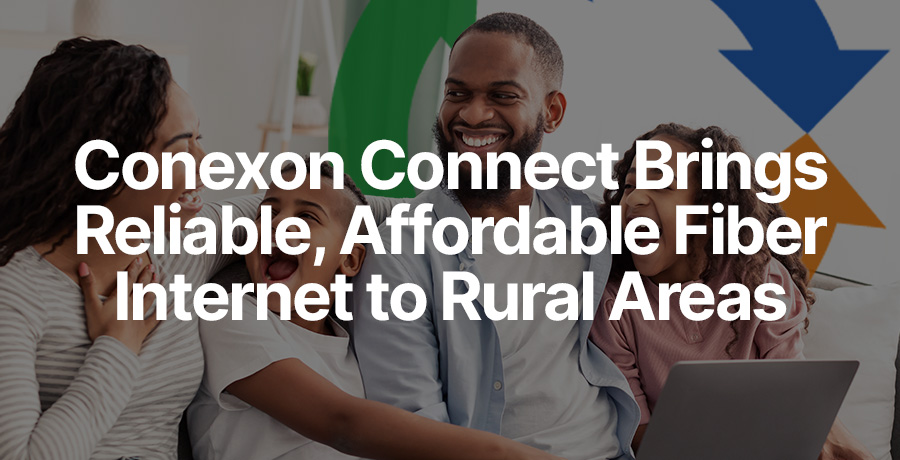The Best Approach to Rural Broadband that No State or Federal Agency Will Adopt
March 11, 2022
Before we dive in:
I want to thank everyone for the overwhelmingly positive reaction to last week’s article on Ukraine.
My admiration for dissidents and my occasional outspokenness are part of the same piece. As some of you may know:
- Years ago, I was fired from the FCC for public comments I made that were critical of large telephone companies.
- Last year, Conexon was excluded from an industry event for being “controversial,” according to an NRECA internal email. For years, Conexon has been denied any speaking opportunity at NRECA events, a directive that comes from the senior leadership (despite Conexon being in the highest tiers of vendor membership and sponsorship).
- Just the other week, I was disinvited from speaking at a public event, out of concern that I might be critical of a state grant program.
- I might begin to take this personally. It is personal – to the rural households where work, school and opportunity have been made more difficult for the lack of broadband. The current system failed rural America for over a decade. Sometimes I can be caustic, but I only advocate for better rural broadband.
The bottom line:
Without pointed advocacy starting a decade ago by co-op leaders Randy Klindt (Co-Mo Connect, OzarksGo), Bob Hance (Midwest Energy & Communications), Alyssa Clemsen Roberts (Utilities Telecom Council, Delta-Montrose Electric Association), Sheila Allgood (Northeast Rural Services, Canadian Valley Electric Cooperative) and Todd Way (Douglas Fast Net):
- Electric co-ops would not have been granted access to federal grants and subsidies.The Rural Electric Cooperative Consortium would not have become the largest recipient of FCC funds in the nation.
- The broad electric co-op fiber-to-the-meter movement would not have become the fastest-growing broadband segment in rural America.
- In this same vein, over the past decade, I have proposed shifting the spending decisions on rural broadband from the federal government and state government agencies to:
1. Local communities
2. Consumers
Community Choice
Allow local communities to determine awards as part of a state broadband funding opportunity.
How it could work:
Qualified applicants would demonstrate consumer interest by submitting a list of local supporters interested in subscribing to their service.
- Households and small businesses in areas eligible for public funding would sign an expression of interest in the applicant’s service.
- This would constitute a local consumer preference area.
- Applicants would have the opportunity to include in their funding request census blocks that comprise such consumer preference areas.
- Funds would be awarded based upon consumer preference and local support.
- If the number of local supporters equals more than 50% of the eligible locations in an area, that applicant would automatically become the winning applicant at a pre-determined model-based or allocation-based amount.
- In the event of overlapping applications where multiple carriers obtain enough support in an area, the applicant with the higher percentage of support in any given census block or census block group would win that area and receive the funding.
Consumer Choice
And let the broadband subsidies follow a rural consumer’s choice.
Allow consumers to port their subsidies just as they can port their phone number.
How it could work:
Use a cost model, such as the FCC’s Connect America cost model, to determine the appropriate level of subsidy for each location in each rural census block.
- The FCC has already used this model to calculate a level of subsidy necessary to build and provide fiber service to every location in every census block throughout the country.
- Make available monthly such support to all eligible telecommunications carriers (ETC).
- Limit the program to one subsidy per location, similar to the limitation of the Lifeline program of one subsidy per household.The subscriber count of each ETC should include only broadband service that has been determined to be comparable to service available in urban areas. (See previous Co-ops Connect FYI issue on this topic)
- Compensate each ETC based upon the number of locations served with broadband and the subsidy per location per census block.
Any ISP could win back a customer it loses, and thereby win back the subsidy amount.
Final Thoughts
The bottom line:
- This model will encourage ISPs to continue to improve service offerings even in rural areas, and allow public funds to follow ongoing consumer decisions, rather than pre-set government decisions.
- The FCC and state broadband offices would get out of the business of determining the type of technology and attempting to compare the relative weights of technologies (regardless of what type of service is chosen).
Why it matters:
If we change the locus of decision making to local communities and consumers:
- The power will shift from lobbying and campaign contributions to service and investment.
- The shift would spur ongoing rural investment.
- The shift would prevent most rural areas from being locked into one technology or one service provider.

